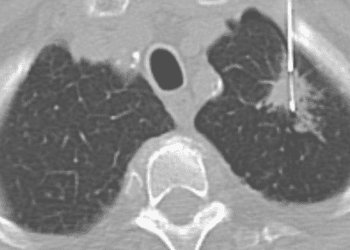Ponsegromab improves boy weight in cancer-related cachexia
1. Ponsegromab significantly increased body weight in patients with cancer cachexia and elevated GDF-15 levels compared to placebo at 12 weeks.
2. Improvements in appetite, cachexia symptoms, and physical activity were observed at the 400 mg dose, with no serious adverse events attributed to the drug.
Evidence Rating Level: 1 (Excellent)
Study Rundown: Malignancy can impact energy levels, weight, appetite, and overall quality of life. Cachexia in malignancy is also associated with an increased risk of death. In cancer patients with cachexia, it has been noted that growth differentiation factor 15 (GDF-15) levels are elevated. There is not yet clear evidence as to whether GDF-15 inhibition improved cachexia-related symptoms in those with malignancy. This randomized, double-blind, placebo-controlled trial evaluated the efficacy of ponsegromab, a monoclonal antibody inhibiting GDF-15, in patients with cancer cachexia and elevated GDF-15 levels. Participants receiving ponsegromab (100 mg, 200 mg, or 400 mg doses) showed significant increases in body weight compared to placebo, with the largest weight gain in the 400 mg group. Improvements in appetite, cachexia symptoms, and physical activity were also seen in the 400 mg group. Adverse events occurred at similar rates in both groups and were generally mild to moderate. Limitations include the short 12-week study duration and the relatively small sample size.
Click to read the study in NEJM
In-Depth [randomized controlled trial]: The trial was a 12-week, randomized, double-blind, placebo-controlled phase 2 study evaluating ponsegromab, a monoclonal antibody targeting GDF-15, in patients with cancer cachexia. Eligible participants were adults with cancer (non–non-small-cell lung, pancreatic, or colorectal cancer), significant weight loss (>5% in six months), and elevated serum GDF-15 levels (≥1500 pg/mL). Participants were randomly assigned in a 1:1:1:1 ratio to receive subcutaneous ponsegromab (100 mg, 200 mg, or 400 mg) or placebo every 4 weeks for three doses. The primary endpoint was the change in body weight at 12 weeks. Patients in the 100 mg group demonstrated a median weight gain of 1.22 kg (95% Credible Interval [CI], 0.37–2.25, posterior probability, <0.05) compared to placebo, 1.92 kg ([CI], 0.92–2.97, posterior probability, <0.05) in the 200 mg group, and 2.81 kg ([CI], 1.55–4.08, posterior probability, <0.05) in the 400 mg group. The lumbar skeletal muscle index improved by 2.04 cm²/m² ([CI] 0.27–3.83) in the 400 mg group. Improvements in appetite and cachexia symptoms were observed, as measured by the Functional Assessment of Anorexia Cachexia Treatment–Anorexia Cachexia Subscale (FAACT-ACS), with a 4.50-point increase ([CI], 1.29–7.77) in the 400 mg group and a 2.4-point increase ([CI], 0.86–7.34) in the 100 mg group. Physical activity, assessed through wearable devices showed patients in the 400 mg group increased non-sedentary activity by 72 minutes ([CI], 37–107) per day compared to placebo. Serious adverse events were comparable between the ponsegromab (22–40%) and placebo (24%) groups. The most common side effects were diarrhea, anemia, and hypokalemia. Overall, the study demonstrated that GDF-15 inhibition with ponsegromab resulted in meaningful weight gain, improved appetite, increased physical activity, and preserved muscle mass in patients with cancer cachexia.
Image: PD
©2025 2 Minute Medicine, Inc. All rights reserved. No works may be reproduced without expressed written consent from 2 Minute Medicine, Inc. Inquire about licensing here. No article should be construed as medical advice and is not intended as such by the authors or by 2 Minute Medicine, Inc.


![2 Minute Medicine: Pharma Roundup: Price Hikes, Breakthrough Approvals, Legal Showdowns, Biotech Expansion, and Europe’s Pricing Debate [May 12nd, 2025]](https://www.2minutemedicine.com/wp-content/uploads/2025/05/ChatGPT-Image-May-12-2025-at-10_22_23-AM-350x250.png)




